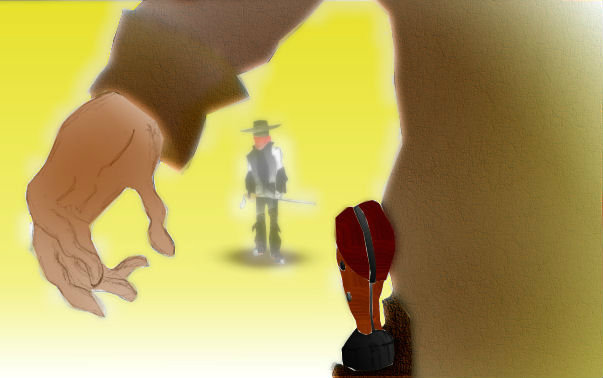“Gunfight at the O.K. Corral”: Pierpont vs. Schomer
Aug 9, 2013

Editor’s note: Paul Schomer is an acoustical engineer of distinction. (Click here to read his resumé and here to visit his company website.) Which explains why Nina Pierpont was especially exercised when she read his latest report on health effects from industrial wind turbines (IWT’s).
Click here to read it.
Anyone familiar with Pierpont’s research will immediately recognize the eye-popping correspondence between Schomer’s latest research and Pierpont’s 2009 book on Wind Turbine Syndrome. In Pierpont’s mind, as you will see below, that startling correspondence crosses the line from “Gee, we’re both working on the same thing!” to “Oh my God, this guy pirated key elements from my work, without crediting me!”

So, Pierpont did what any offended pioneering woman scientist would do. Loaded her Colt Peacemaker, pinned on her “sheriff” badge, contacted Schomer and demanded satisfaction—or his hide! (See following email.)

So began a fruitful and fascinating correspondence, not just between these two titans, but soon including a dozen or so bystanders who took it upon themselves to weigh in. (We will be publishing some of the correspondence contributed by “bystanders.” Including Dr. Malcolm Swinbanks, Dr. Sarah Laurie, Curt Devlin, Eric Bibler, Eric Rosenbloom, George Kamperman, Jane Davis, Itasca Small, and others. We have secured their permission to reprint, and will post their pieces in the next day or two.)
It is this “ferment,” this dialogue (sometimes with live rounds—from popguns), that makes this website especially valuable.
(In case you’re wondering, this story has a happy ending for both Dr. Schomer and Dr. Nina. Read on.)
From: Nina Pierpont, MD (Johns Hopkins), PhD (Princeton, Population Biology)
To: Paul Schomer, PhD (Univ. of Illinois, Electrical engineering/Acoustics)
Date: 8/5/13 (revised 8/8/13)Regarding: Your unacceptable failure to credit my work
Dear Dr. Schomer,
I have reviewed your manuscript for your presentation at the 5th International Conference on Wind Turbine Noise, to be presented later this month. (See attached, “A proposed theory to explain some adverse physiological effects of the infrasonic emissions at some wind farm sites.”) This manuscript is in the public domain, as you submitted it to the Wisconsin Public Service Commission on July 29, 2013.
I have also read the Shirley, Wisconsin infrasound and resident symptom monitoring report of December 27, 2012 (click here).
I am aware, as well, that you personally ordered and were sent (on April 24, 2013) my original research on the clinical effects of exposure to wind turbine noise, published as a peer-reviewed book called “Wind Turbine Syndrome” in November 2009.
I admire your work enormously, and am delighted that someone of your stature in the acoustical community has undertaken to fill in the specific gaps in my own work (which I could not fill, being a physician and population biologist, not a noise engineer or an experimental physiologist). These gaps being, first, measurement of the specific relevant acoustic energies and, second, a specific mechanism for how airborne infrasound manages to perturb the otolith organs (a phenomenon on which there is disagreement among vestibular researchers, I find).
You and others (your colleagues in the Shirley study, and Rick James and Wade Bray) have demonstrated the relevant sound energies. Alec Salt has demonstrated why we don’t hear the low frequencies and proposed a mechanism based on signals to the brain from the outer hair cells of the cochlea. You have now proposed a specific force transduction model for how airborne infrasound might impinge on the otolith organs, and compared this to the whole-body forces experienced by nauseated pilot trainees.
What I did was detailed, structured before-during-after exposure symptom interviews on more and less affected people, including all household members within households where there was at least one severely affected person (thus ensuring that all participants were exposed to clinically adequate levels of sound energy, eliminating level of sound energy as a variable). I also did detailed clinical interviews on all participants for their baseline health status, allowing me to statistically analyze the group for the presence of risk factors, thus addressing what I laid out at the beginning as the main focus of my research—why some people are affected and others not. Motion sensitivity was one of the statistically significant risk factors. So was preexisting migraine disorder and preexisting damage to the inner ear through industrial noise exposure or chemotherapy.
The nature of the risk factors was then used as the basis for my hypothesis that the low frequency noise or infrasound disturbs the vestibular system and in particular the utricle or saccule, as well as potentially activating important position-detecting receptors in the viscera of the chest or abdomen, which are the recently discovered 4th sensory arm of our body systems for detecting motion and position (the other 3 being vision, vestibular, and somatosensory, as you know). Once the vestibular system in the broad sense is perturbed, many symptoms can result, including nausea, unsteadiness, anxiety and panic (even causing panicked awakening from sleep), and difficulty concentrating and thinking, especially visual-spatial thinking. There is a broad clinical and anatomic literature behind this broader concept of vestibular disturbance.
Dr. Schomer, I see three of my own contributions in your July paper which were absent from your December (Shirley, Wis.) report. I find this disturbing, as you do not refer to my work in any way in your July paper. Yet you consider this to be an academic paper, not just a government report.
The ideas that I believe you picked up from my published book are 1) the idea of a risk or susceptibility factor for being affected, to explain why some people are affected and others not, 2) the idea of deriving a probability for chance association between a risk factor and a symptom (though you didn’t actually know how to do it—more below), and 3) attributing the symptom to perturbation of the otolith organs. The idea of low-frequency noise perturbing the otolith organs in fact originated with me, as I know from literature review and consultation with neuro-otologists during the writing of my book in 2008.
In academic scientific writing, as I expect you know, even well-accepted, common ideas are often referenced with one or two classic citations; new ideas are absolutely cited. Thus I think that you were working in haste—or possibly lacking in integrity? (Perhaps you thought that, because the wind industry has used every method to bury me and my work, that somehow—though a published book and peer reviewed, with the reviews included in the book, in case anyone was in any doubt—you could disregard it, even as you seemingly absorbed and, I believe, reproduced parts of it.)
In case you thought you got any of the above ideas from Rob Rand, he and I had a lot of communication after he developed his symptoms in Falmouth, Mass., including his reading my book and contacting me in amazement at the accuracy of my descriptions of what he had just experienced for the first time (despite years of working on other types of community noise), and a many-hour conversation at his home in Brunswick, Maine. These ideas still need to be credited to my published work.
With regard to your analysis of the significance of the association you found between motion sensitivity and susceptibility to wind turbine disturbance—you don’t need to reinvent statistics, and you don’t need to use a population estimate of the frequency of the trait. You can just use a simple 2 x 2 contingency test like a Chi-squared or Fisher exact test, in which your 4 cells are 1) people with symptoms and sensitivity; 2) people with symptoms but without sensitivity; 3) people without symptoms and with sensitivity; and 4) people without symptoms and without sensitivity. In this instance you derive your own population frequency of each trait in your sample population, and use the test to see if they are significantly associated with each other. (I wonder, though, if you had data on all 50 symptomatic people with regard to their motion sensitivity or presence of the symptom of nausea. Perhaps you were just using a seat-of-the-pants calculation in the absence of this data.)
I would think a sentence like, “Pierpont (2009) showed a statistically significant relationship between motion sensitivity and the most severe symptom set, including nausea, panicked awakenings, and vibratory sensations inside the chest, further demonstrating that motion sensitivity is an important risk factor for the level of symptom severity that drives people from their homes,” would only strengthen your work.
Some have suggested that we should collaborate, which of course makes sense when two researchers have come to a common conclusion but have different strengths and expertise. However, at this point, I believe that you have taken and used without attribution several specific, published ideas of mine about the very subject you are researching.
I will be very interested in your reply. I expect that appropriate attribution will be inserted into your paper before it is presented in an academic setting such as the conference at the end of this month. If you do not do this, I will contact the conference organizers, INCE (Institute of Noise Control Engineering), and the Acoustic Society to share my concerns with them. If the paper appears in a journal without appropriate attribution, I will do the same with the editor.

Dr. Schomer replied later that day (8/5/13). He blew her off. Entirely. His opening line: “Everything I put in my paper, I developed on my own.” He then elaborated on his position, mainly by asserting a half dozen untruths (called “straw men”) regarding Pierpont’s research, and then—naturally—shooting them down.
The only problem with his depiction of Pierpont’s work is that . . . she never made the claims he says she did. Oops!
But wait a minute: In his Shirley (Wisconsin) report, in December 2012—before he bought the book—Schomer trots out none of Pierpont’s work. Six months later, after buying her book—he trots out her stuff without attribution. According to Pierpont, there are points he makes which he could not have gleaned except from her work—either first-hand or second-hand.
Yet, according to his reply, she was irrelevant to his (identical) thinking. Hmm.

“Smells fishy,” by Nate Owens
Since I don’t have Dr. Schomer’s permission to reprint his response, all I can do is summarize the gist of it, here.
Then a light went on in Nina’s head. She re-read his reply. She talked to some people who know his work and who know him, personally. “Hmm. Maybe we’re talking past one another!”

That evening, Pierpont dialed down the rhetoric and extended an “olive branch” (8/5/13):
Dear Paul (if I may),
Thank you for your reply, and I appreciate it that you are actually now going to read my work.
I realize I made you very angry, so you may not have considered my letter so carefully, but I (of course!) did not claim to have originated the idea of the correlation between seasickness and infrasound exposure. What I could not find any reference to when doing the research for the book was the idea that infrasound could disturb the otolith organs. In fact, my suggestion that it could made one researcher, Neil Todd in England, quite indignant, saying that his work on vibration measurably affecting otolith organs in normal human subjects could most definitely not be extended to airborne infrasound. I got an opposite opinion from Steve Rauch, MD, head of vestibular research at Mass Eye & Ear in Boston, saying that airborne infrasound could reach the inner ear via the tympanic membrane.
That is why I am delighted with your work–you take on this issue. Alec Salt and I have had a debate on this since we presented back to back, answered questions together, and sat together at the wind turbine noise and health conference in Picton, Ontario in 2010. In his model, we know the mechanics of the effects of infrasound on the outer hair cells of the cochlea, but nothing about the effects of outer hair cell nerve signals on the brain once they get past the auditory nuclei; he just calls these “subconscious effects” to explain their effects on symptoms and behavior. I have been insisting throughout that these are vestibular effects of infrasound, because the set of symptoms is congruent with other diseases of the vestibular organs (with symptom sets that extend far beyond nausea), but otologic researchers were not in agreement about whether airborne infrasound could impact the vestibular organs. In terms of a chain of events, Alec’s model is a black box after signals reach the brain. In my model, there is only one little black box, a missing link, in the question of how infrasound impinges on the inner ear. Once signals reach the brain, there is massive congruence between what vestibular disease does and what wind turbine syndrome sufferers experience.
In reading my book, please read the clinical chapter. I gather you have already read the symptom accounts.
One other “straw man” in your reply to me—I have never said that everyone is affected inside any radius, whether it is 2 km (the setback I propose in the book, since I had affected subjects at 1.5 km), 2 miles (which I suggested for mountainous regions), or Sarah Laurie’s extremely long radii for effects in Australia. My work, as I said, is entirely about risk factors for being affected by infrasound and about the complex phenomena of vestibular-linked brain effects, which I show to be present in this situation of noise-induced disease.
All the best,
Nina
The olive branch bore fruit. Dr. Schomer contacted her several days later and suggested she call him, and they . . . talk.

So she did. He’s finally reading her book. They’ve agreed to keep up the dialogue.
There’s still the vexing issue of where he got his ideas, and why he didn’t “reference” Pierpont. But we will leave that to the two of them to hash out—with an olive branch, instead of two blazing Peacemakers.
Stay tuned.


Comment by Colette McLean on 08/09/2013 at 8:23 pm
After perusing Dr. Schomer’s paper, I couldn’t help feel the intent was to actually minimize the number of impacted residents by indicating that it is even a smaller subset of people (those who easily suffer seasickness) who are being affected. Perhaps this was a way to strike the balance between what he is witnessing as a professional and his work as an acoustician with the wind industry.
Comment by Kaz on 08/10/2013 at 5:13 pm
As a ‘Peacemaker’ of the human sort, I am extremely pleased that Dr. Schomer and Dr. Pierpont have begun this dialogue and I’m thrilled that so many experts and victims weighed in on the correspondencee between the two professionals.
I found myself wondering if Dr. Schomer realized what a treasure trove of first-hand information he had at his fingertips. It is essential that we begin to pool our resources so that unbiased experts have the tools they need to study and report out on this very important topic.
My thanks to all who are willingly sharing their expertise and experiences. WTS is real. We know it. The wind industry knows it. Now… it’s time for the public to learn the science behind this dangerous and debilitating impact of wind turbine noise emissions.
Kaz